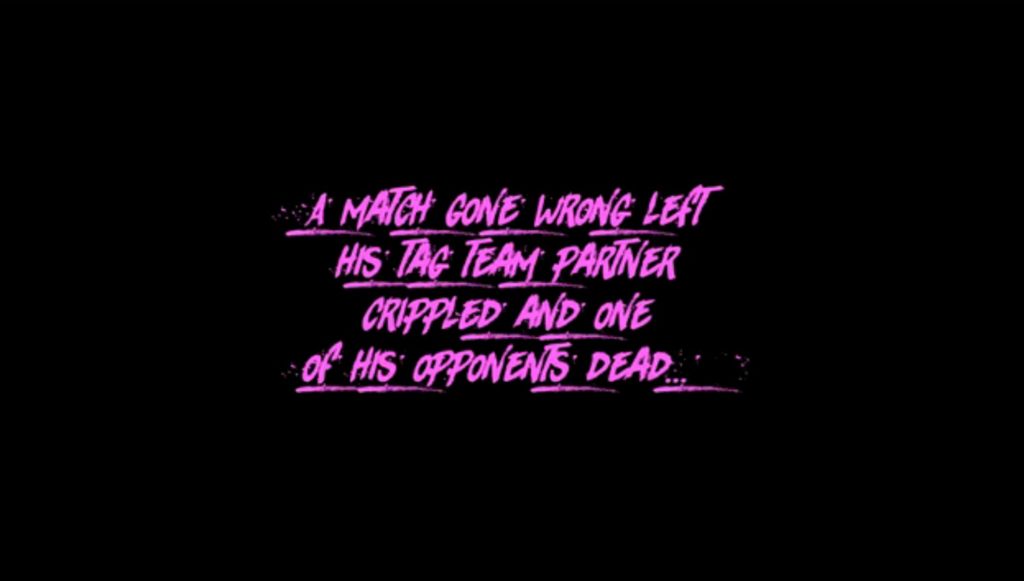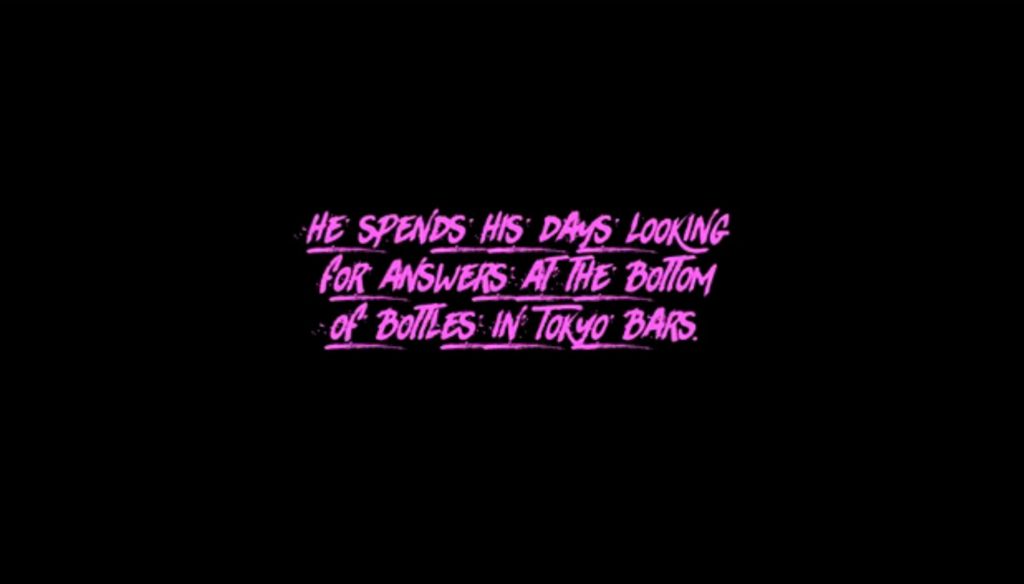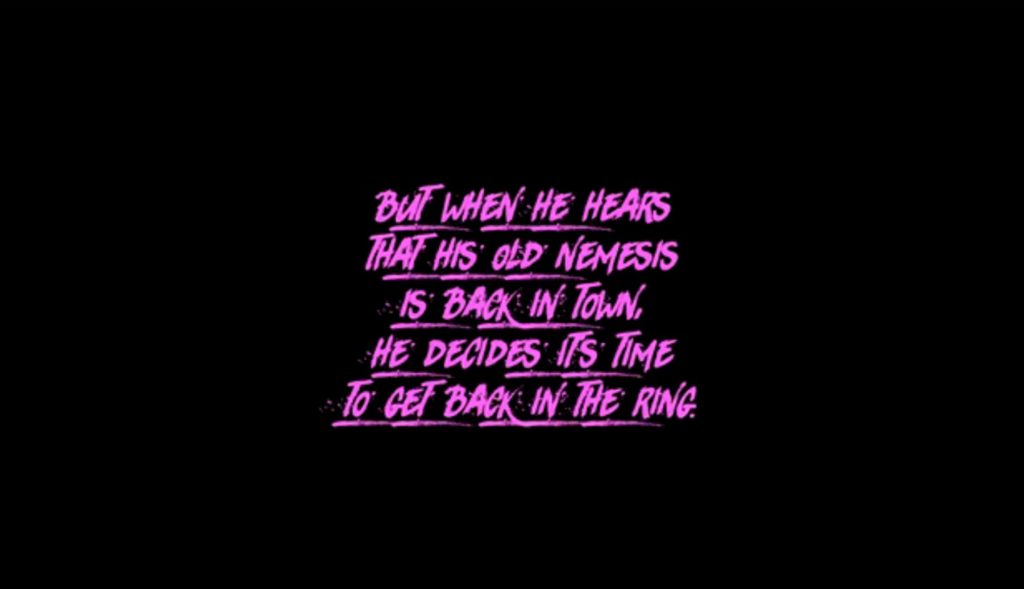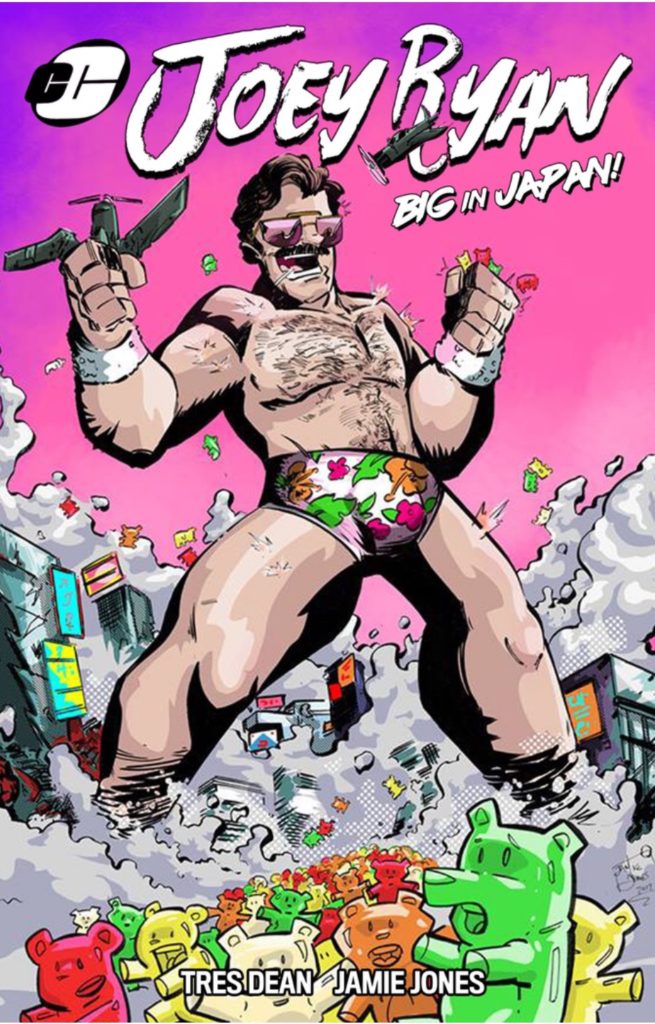Remember that GIF you saw once of a wrestler destroying his opponent simply with the power of his own penis? This GIF:

Well, that wrestler’s starring in his own comic… as the Chiodo Comics’ funding Kickstarter makes it into the black. At time of writing there are no stretch goals announced, but with the campaign closing in the early days of May there’s time for news on that front yet. With digital copy tiers from $5 and perks from art prints to signed photos to t-shirts, stickers and pins, there’s plenty to invite investment while you can. Still kind of ehh on the whole thing? Not sure about the welcome to be found in such a patently macho project? I spoke to scripter Tres Dean about why that may be so, but what he hopes you’ll consider…
Some of us might know Joey Ryan only as that sleazy-looking wrestler with the dick move. I think it’s fair to say that this synopsis could put off a number of our readers, so here’s a hard question to begin with– if that’s a prospective backer’s opinion, why should they actually trust in a) Joey Ryan and b) you and this comic? Introduce your subject and your project.

Tres Dean: This is a really good question, actually, and I’m going to give it a lengthy answer because I think it’s an important point. So for starters, Joey’s character in the storytelling environment of pro wrestling generally works best as a heel. He’s a sleazebag who beats people up with his dick and sticks blow pops in his opponents’ mouths. That’s not what a babyface does. So that being said, he’s the protagonist of this comic. And while there are plenty of great, compelling stories in which the protagonists are villains in the grand scheme of things, that’s not necessarily the sort of nuance we wanted to bring to a 20 page comic about a wrestler with a penis that can flip people over. So the challenge was to create a character that is sympathetic and, ultimately, the good guy in the book without entirely betraying the sleaze factor that Joey’s made a name for himself with.
I think the easy pitch when trying to describe Joey Ryan to people is that he’s Magnum PI/Miami Vice meets Ron Jeremy. So for the book we just decided to play up the former rather than the latter. This is partially because, if we’re being honest, writing 20 pages of dick jokes isn’t really something I’m interested in, whereas writing comics that contain lots of 80’s pop culture influence is very much my wheelhouse. I think Lucha Underground did a great job of balancing that tone, with having his character of the sleazy wrestler be part of a deep cover operation he was working as a cop. It allowed for the scumbag side to still be there in the matches — his handcuffing himself to a post in Aztec Warfare is still kind of a brilliant storytelling point to me – but for the character to be something more than the Dick Spot Guy. So in this comic, we’ve tried to strike a similar balance. We’re very much playing up the 80’s aspects of Joey’s character more than the Viral Dick Spot aspects. And as such, we’ve ended up with a story that draws pretty heavily from 80’s cinema, too: it picks up on Joey in the sort of twilight of his career, a match gone wrong having forced him out of wrestling five years ago. But he finds himself presented with a chance for both revenge and redemption, and ends up drawn back into that world. It’s more Roadhouse than raunchy comedy.
So back to the question of why prospective backers who might be hesitant should trust us: Jamie, Ivan, and I have a lot on the line with this book. It’s Ivan’s first (official) book under the banner of Chido Comics, which hadn’t quite been established when Lucha Underground came out. Similarly, while Jamie and I have our fair share of work under our belts (we’ve made well over 100 pages of our mech-western called DODGER: A Western Saga of Mechs and Mayhem over the last two years), this is probably our most high-profile opportunity so far. And the last thing we’d want from that is a book that paints us as a couple of dudes with the sense of humor of a 12 year old writing 20 pages of jokes about sexual harassment, dick spots, and toilet humor. We take comics, as a storytelling medium, very seriously, and if at any point over the making of this book we got the feeling that what Ivan and Joey wanted from us wasn’t going to be a good use of our abilities or time, we would have walked. But we’re still here because we’ve been afforded the opportunity to tell a story that excites us and utilizes our skills as creators in a way that we think will excite readers.
Maybe this is one for the artist, but let’s do our best. The preview pages on the Kickstarter are very plainly inspired by Ryan’s persona; the colours, in particular, plainly harken to his unique ring gear. Is it easier to define and create a comic based on a single wrestler than it is a whole promotion, as you did with the Lucha Underground title? How does the creative process differ– what are some challenges avoided or newly discovered?
Editor Ivan: It’s a little bit easier with a single wrestler because you only have to worry about one character. In this case we only worry about Joey Ryan’s journey and the other characters around him that help drive the story.
When you tackle something like Lucha Underground, that’s an entire different monster. Each and every wrestler has their individual story and background that led them to the temple. Then eventually their story intertwines to a larger narrative. There’s also a lot of “seed planting” in the Lucha Underground universe.
Some of the challenges we discovered with Lucha Underground, which was our fault for suggesting it, was that we wanted to be the first to make a wrestling comic that was canon to the show. While people waited for Season 2 to begin, we showed the fans what their favourite characters were going through leading up to the new episodes. We even fully unveiled Montana’s character in the comic book before making his appearance on the show. That’s never been done before.
How much negotiation with Ryan himself (or “his people”?) did the pre-production of this book take? You mention licensing fees etc– what sort of input does the subject have to this book? And if not much, why does that workout better for the product in the end?
Tres Dean: So first of all, the licensing fees are basically a flat rate we’re paying Joey for the rights to use his character in the book. He’s in a pretty cool position as a wrestler in that he owns the rights to his character, not a promotion. We’ve also given him complete oversight on the storytelling decisions we’ve made, not out of contractual obligation but more so because we want to make sure we’re making something that honors the character he’s spent so long playing. The good news is that, honestly, at no point in time has he vetoed anything. We’ve run every single idea we’ve had by him for months and he’s never told us no. Which is awesome, because it means that the story we’re telling honors him, but is also very much the story Jamie and I want to be telling.
There’s often suggestion and vague talk about how “comics” and pro- wrestling are so similar — the muscles, the colours, the fights, the melodrama. What do you think a comic brings to a wrestling persona that can’t be captured, or is hard to capture, in the primary mediums of televised and live wrestling? And… how much wrestling did you feel obliged to include in the telling of your story?
This is a great point, and one of the other things I knew going into this project is that I didn’t want to tell a story that could be told through a traditional wrestling format. I’m a big proponent of making sure that there’s a harmonious relationship between the story being told and the medium through which the creator tells it — which is why I’m so averse to comics that are just TV pitches in disguise. So telling a story about Joey’s character through comics as opposed to wrestling allowed for us to explore more of his character’s life outside of the ring. It also allowed for us to sort of best convey the version of this character we’re working with. We get to see the character’s life outside of wrestling, what years of wear and tear have done to his body and mind. Above all, we see what it would take to force this character to hang up his boots for good…and then what it would take to get him back in the ring for one last run.
As far as how much wrestling we felt obligated to show? Not a ton at first, just by the nature of the story we’re telling. But the book builds to Joey’s first match in five years, and we definitely want to make sure that one match counts.

***
Convinced? Either way, here’s that link again, just in case you need it.





